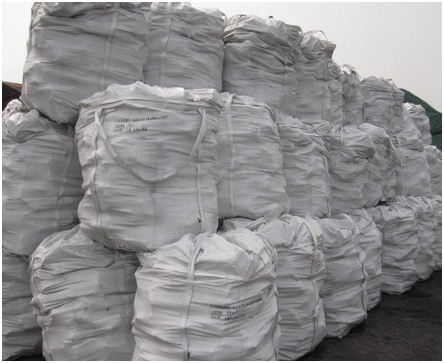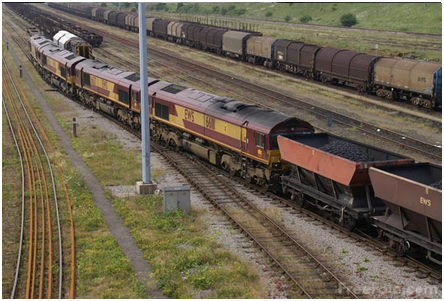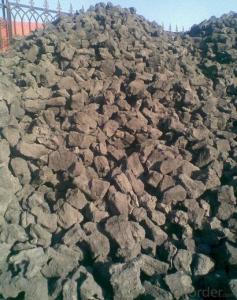Recarburizer of coke supplier Carburant
- Loading Port:
- Dalian
- Payment Terms:
- TT OR LC
- Min Order Qty:
- 10 m.t
- Supply Capability:
- 500000 m.t/month
OKorder Service Pledge
Quality Product, Order Online Tracking, Timely Delivery
OKorder Financial Service
Credit Rating, Credit Services, Credit Purchasing
You Might Also Like
Specification of Recarburizer:
Supply recarburizer 5--15mm
- Quick delivery with strong package
- Competitive price
- best seller
Recarburizer Data Sheet:
F.C | 98%MIN |
ASH | 0.3%MAX |
VM | 1.5%MAX |
S | 0.5%MAX |
SIZE | 5--15MM |


- Q:How does carbon contribute to the strength of concrete?
- Carbon contributes to the strength of concrete by reinforcing it through the formation of calcium silicate hydrate (C-S-H) gel. This gel fills in the gaps in the concrete matrix, enhancing its density and reducing porosity. Additionally, the carbonaceous material reacts with calcium hydroxide (a byproduct of cement hydration), producing calcium carbonate. The formation of calcium carbonate increases the overall strength and durability of the concrete structure.
- Q:What are the uses of carbon black?
- Carbon black is primarily used as a reinforcing filler in tires and other rubber products to improve their durability and strength. Additionally, it is widely employed as a pigment in inks, coatings, and plastics due to its ability to provide color and UV protection. Carbon black also finds applications in batteries, electrodes, conductive materials, and as a catalyst support in chemical reactions.
- Q:Can carbon be recycled?
- Yes, carbon can be recycled.
- Q:How is carbon used in water filtration systems?
- Carbon is commonly used in water filtration systems due to its impressive adsorption properties. Adsorption involves the molecules of a substance binding to the surface of another material, in this case, carbon. Activated carbon, which is carbon that has been specially processed to create a large surface area, is particularly effective in water filtration. When water passes through the filtration system, the carbon captures and retains a wide range of impurities, including organic compounds, chlorine, volatile organic compounds (VOCs), and certain heavy metals. This adsorption process helps to remove unpleasant odors and tastes from the water, making it more palatable. Carbon also plays a crucial role in removing potentially harmful contaminants such as pesticides, herbicides, and pharmaceutical residues. Additionally, carbon filtration systems can help reduce the risk of waterborne illnesses by removing bacteria, viruses, and parasites. Overall, carbon is an essential component of water filtration systems as it significantly improves the quality and safety of drinking water.
- Q:What is electrical carbon?
- The main component of electrical carbon material is carbon. Because of the different structures, carbon has two types: crystalline carbon and amorphous carbon. Crystalline carbon is mainly composed of graphite, amorphous carbon, mainly coke, charcoal, carbon black and so on. Coal used daily is an impure amorphous carbon.Graphite has a crystalline structure of six square system. It has numerous parallel layers superimposed on each layer of carbon atoms at the top angles of the six angles plane, forming an ordered arrangement of three-dimensional space. Because the distance between the layers of the graphite crystal is much larger than the distance between the carbon atoms on the surface, the graphite has an obvious anisotropy. When there is external force, the surface of graphite is easy to slip, so it shows self lubrication characteristics. In high purity graphite crystals, the valence band overlaps the conduction band, so the high conductivity of the metalloid is demonstratedThe arrangement of carbon atoms in amorphous carbon is haphazard, and it is easier to slip than the graphite layer, and its hardness is 4~5 times higher than that of graphite. Amorphous carbon, if treated at 2 200~2 5000C high temperature, can transform the disordered structure into an ordered arrangement of two-dimensional space.
- Q:Joint carbide gas incident
- The Central Bureau of investigation in India after the disaster had 12 official allegations, including the Union Carbide (India) Co., Ltd. India 8 executives when he was chairman of Warren Anderson and company, two small companies and the company itself and under the. The 1 indicted India executives have been killed, the court 7 days to negligence causing death sentence the remaining 7 India nationals guilty, including the then Indian president Keshub Mahindra is more than 70 years old, many people. According to the charges, they will be sentenced to two years in prison at most. Survivors of the gas leak and their families and local activists gathered in front of the court 7 days ago, holding banners protesting the punishment of the perpetrators too light and late. Since the conviction was made in a local court in India, the defendant had the right to appeal to a higher court, and it was estimated that the process would continue for several years. After the disaster, Anderson, the American boss of the company, returned home soon. Now he lives in New York. In July last year, the court issued an arrest warrant for Anderson, but it has not been mentioned below.
- Q:What are the impacts of carbon emissions on natural disasters?
- Carbon emissions have a significant impact on natural disasters, exacerbating their intensity and frequency. One of the most prominent effects of carbon emissions is the contribution to global warming and climate change. As carbon dioxide and other greenhouse gases accumulate in the atmosphere, they trap heat and cause the Earth's temperature to rise. This rising temperature leads to various changes in weather patterns, which in turn increase the likelihood and severity of natural disasters. One of the most obvious impacts of carbon emissions on natural disasters is the intensification of hurricanes and tropical storms. Warmer ocean temperatures provide more energy for these storms, making them stronger and more destructive. Additionally, increased evaporation due to higher temperatures leads to heavier rainfall during storms, increasing the risk of flooding and landslides. Carbon emissions also contribute to the melting of glaciers and polar ice caps, leading to rising sea levels. This rise in sea levels increases the vulnerability of coastal areas to storm surges and flooding during hurricanes and typhoons. Low-lying regions and island nations are particularly at risk, as they face the possibility of losing their land to rising waters. Furthermore, carbon emissions play a role in the occurrence and severity of wildfires. As temperatures rise, vegetation becomes drier, creating ideal conditions for wildfires to ignite and spread quickly. These wildfires can devastate vast areas of land, destroying ecosystems, homes, and livelihoods. Another impact of carbon emissions on natural disasters is the disruption of weather patterns. Climate change is altering rainfall patterns, leading to longer and more severe droughts in some regions, while others experience more frequent and intense rainfall events. These changes in precipitation patterns can result in prolonged droughts, water scarcity, and increased risk of wildfires in some areas, while others face increased flooding and landslides. In conclusion, carbon emissions have a profound impact on natural disasters. They contribute to global warming and climate change, intensifying hurricanes, increasing the risk of flooding, raising sea levels, fueling wildfires, and disrupting weather patterns. It is crucial to reduce carbon emissions and transition to clean and sustainable energy sources to mitigate these impacts and protect our planet from the devastating effects of natural disasters.
- Q:What are the implications of melting permafrost on carbon emissions?
- The melting of permafrost has significant implications on carbon emissions. Permafrost contains large amounts of organic matter, such as dead plants and animals, which have been frozen and stored for thousands of years. When permafrost thaws, this organic matter decomposes and releases carbon dioxide and methane, two potent greenhouse gases. These greenhouse gases further contribute to global warming, exacerbating climate change. Additionally, the release of carbon from melting permafrost creates a positive feedback loop, as increased global temperatures lead to more permafrost thawing, causing even more carbon emissions. This highlights the urgent need to address permafrost melting as part of efforts to mitigate climate change.
- Q:How does carbon impact the prevalence of tsunamis?
- Carbon dioxide does not directly impact the prevalence of tsunamis. Tsunamis are primarily caused by undersea earthquakes, volcanic eruptions, or underwater landslides. These events release massive amounts of energy into the water, generating powerful waves that can travel across the ocean and cause devastating destruction when they reach the coast. While carbon dioxide emissions do not directly cause tsunamis, they are linked to climate change, which can indirectly influence the occurrence and impact of these natural disasters. Increased levels of carbon dioxide and other greenhouse gases in the atmosphere contribute to global warming, resulting in rising sea levels. As sea levels rise, coastal areas become more vulnerable to the destructive power of tsunamis, as the waves can penetrate further inland. Furthermore, climate change can also affect the frequency and intensity of extreme weather events, such as hurricanes and tropical storms. These weather patterns can trigger underwater landslides or enhance the chances of volcanic eruptions, both of which can lead to tsunamis. In conclusion, while carbon dioxide emissions do not directly cause tsunamis, they play a role in the broader context of climate change, which can indirectly impact the prevalence and impact of tsunamis through rising sea levels and the potential for more frequent extreme weather events.
- Q:How is carbon used in the production of filters?
- Due to its unique properties, carbon finds common usage in filter production. One of the primary applications of carbon in filters is its capacity to adsorb impurities and contaminants, attracting and retaining them. This is attributed to carbon's extensive surface area and multitude of minute pores, enabling it to effectively capture and eliminate particles, chemicals, and odors from substances like air, water, and more. In air filters, carbon is frequently combined with other materials, such as activated charcoal, to form activated carbon filters. These filters are utilized to eradicate air pollutants, allergens, and odors. The activated carbon adsorbs the contaminants, entrapping them within its porous structure and ultimately enhancing the overall air quality. In water filters, carbon can be employed in diverse forms, like granular activated carbon (GAC) or carbon block filters. GAC filters are widely utilized in household water filtration systems and are adept at eliminating chlorine, volatile organic compounds (VOCs), pesticides, and other chemicals. Conversely, carbon block filters are produced by compressing activated carbon into a solid block, thus providing a greater surface area and superior filtration efficiency. Apart from air and water filters, carbon is also utilized in various other filter types, such as those utilized in industrial processes, gas masks, and respirators. The versatility of carbon in filtering applications stems from its capability to adsorb a broad range of contaminants and its high adsorption capacity. Its inclusion in filters aids in enhancing the quality and safety of the substances undergoing filtration, rendering it an indispensable material in numerous filtration processes.
1. Manufacturer Overview |
|
|---|---|
| Location | |
| Year Established | |
| Annual Output Value | |
| Main Markets | |
| Company Certifications | |
2. Manufacturer Certificates |
|
|---|---|
| a) Certification Name | |
| Range | |
| Reference | |
| Validity Period | |
3. Manufacturer Capability |
|
|---|---|
| a)Trade Capacity | |
| Nearest Port | |
| Export Percentage | |
| No.of Employees in Trade Department | |
| Language Spoken: | |
| b)Factory Information | |
| Factory Size: | |
| No. of Production Lines | |
| Contract Manufacturing | |
| Product Price Range | |
Send your message to us
Recarburizer of coke supplier Carburant
- Loading Port:
- Dalian
- Payment Terms:
- TT OR LC
- Min Order Qty:
- 10 m.t
- Supply Capability:
- 500000 m.t/month
OKorder Service Pledge
Quality Product, Order Online Tracking, Timely Delivery
OKorder Financial Service
Credit Rating, Credit Services, Credit Purchasing
Similar products
New products
Hot products
Hot Searches































